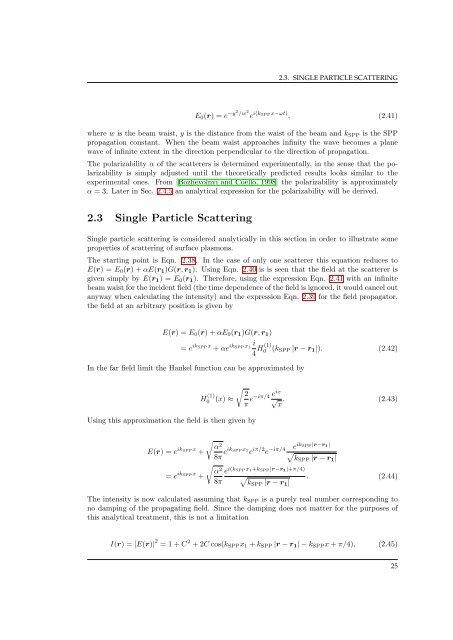P7 – Scattering of Surface Plasmon Polaritons by Gold ... - repetit.dk
P7 – Scattering of Surface Plasmon Polaritons by Gold ... - repetit.dk
P7 – Scattering of Surface Plasmon Polaritons by Gold ... - repetit.dk
Create successful ePaper yourself
Turn your PDF publications into a flip-book with our unique Google optimized e-Paper software.
2.3. SINGLE PARTICLE SCATTERING<br />
E0(r) = e −y2 /w 2<br />
e i(kSPPx−ωt) , (2.41)<br />
where w is the beam waist, y is the distance from the waist <strong>of</strong> the beam and kSPP is the SPP<br />
propagation constant. When the beam waist approaches infinity the wave becomes a plane<br />
wave <strong>of</strong> infinite extent in the direction perpendicular to the direction <strong>of</strong> propagation.<br />
The polarizability α <strong>of</strong> the scatterers is determined experimentally, in the sense that the polarizability<br />
is simply adjusted until the theoretically predicted results looks similar to the<br />
experimental ones. From [Bozhevolnyi and Coello, 1998] the polarizability is approximately<br />
α = 3. Later in Sec. 2.4.5 an analytical expression for the polarizability will be derived.<br />
2.3 Single Particle <strong>Scattering</strong><br />
Single particle scattering is considered analytically in this section in order to illustrate some<br />
properties <strong>of</strong> scattering <strong>of</strong> surface plasmons.<br />
The starting point is Eqn. 2.38. In the case <strong>of</strong> only one scatterer this equation reduces to<br />
E(r) = E0(r) + αE(r1)G(r, r1). Using Eqn. 2.40 is is seen that the field at the scatterer is<br />
given simply <strong>by</strong> E(r1) = E0(r1). Therefore, using the expression Eqn. 2.41 with an infinite<br />
beam waist for the incident field (the time dependence <strong>of</strong> the field is ignored, it would cancel out<br />
anyway when calculating the intensity) and the expression Eqn. 2.39 for the field propagator,<br />
the field at an arbitrary position is given <strong>by</strong><br />
E(r) = E0(r) + αE0(r1)G(r, r1)<br />
= e ikSPPx i ikSPPx1<br />
+ αe<br />
4 H(1) 0 (kSPP |r − r1|). (2.42)<br />
In the far field limit the Hankel function can be approximated <strong>by</strong><br />
Using this approximation the field is then given <strong>by</strong><br />
H (1)<br />
<br />
2 eix<br />
0 (x) ≈ e−iπ/4 √ . (2.43)<br />
π x<br />
E(r) = e ikSPPx <br />
α2 +<br />
8π eikSPPx1e iπ/2 e −iπ/4 eikSPP|r−r1| <br />
kSPP |r − r1|<br />
= e ikSPPx <br />
α2 e<br />
+<br />
8π<br />
i(kSPPx1+kSPP|r−r1|+π/4)<br />
. (2.44)<br />
kSPP |r − r1|<br />
The intensity is now calculated assuming that kSPP is a purely real number corresponding to<br />
no damping <strong>of</strong> the propagating field. Since the damping does not matter for the purposes <strong>of</strong><br />
this analytical treatment, this is not a limitation<br />
I(r) = |E(r)| 2 = 1 + C 2 + 2C cos(kSPPx1 + kSPP |r − r1| − kSPPx + π/4), (2.45)<br />
25


